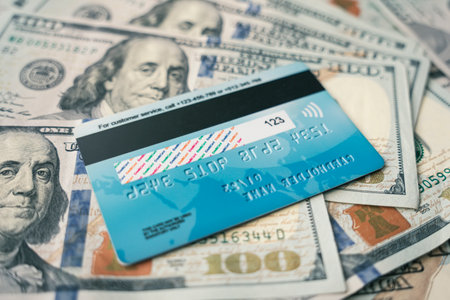Understanding Emergency Funds
If you’ve ever faced an unexpected medical bill, a car repair, or sudden job loss, you know how fast life can throw curveballs. This is why every American household should have an emergency fund. But what exactly is an emergency fund, and why is it so important?
What Is an Emergency Fund?
An emergency fund is money set aside specifically for unplanned expenses. Unlike your regular savings or checking account, this money isn’t for vacations, shopping sprees, or planned purchases. It’s your financial safety net when the unexpected happens.
Purpose of an Emergency Fund
The main goal of an emergency fund is to help you cover urgent costs without having to rely on borrowing money or using credit cards. Here’s how having one can make a difference:
| Emergency Fund | Credit Card |
|---|---|
| No interest charges | High interest rates |
| Immediate access to cash | May max out your limit quickly |
| No long-term debt | Potential for increasing debt cycle |
| Reduces financial stress | Can create more financial anxiety |
Why Every Household Needs One
In America, where healthcare costs can be high and layoffs can happen suddenly, an emergency fund is not a luxury—it’s a necessity. Even setting aside a small amount each month can add up over time and protect you from having to borrow in a crisis. Whether you’re single, married, or supporting a family, having three to six months’ worth of living expenses in a separate account gives you peace of mind and keeps you financially secure when life gets unpredictable.
2. The Role of Credit Cards in Financial Planning
How Americans Commonly Use Credit Cards
Credit cards are a staple in many American wallets. They’re widely used for everyday purchases like groceries, gas, and online shopping. Many people also use them to pay for larger expenses and take advantage of rewards programs that offer cash back, points, or travel perks. It’s not uncommon for families to rely on credit cards during tight months or when facing unplanned bills.
Benefits of Using Credit Cards Responsibly
When used wisely, credit cards can be a powerful financial tool. Here are some key benefits:
| Benefit | Description |
|---|---|
| Building Credit History | Making on-time payments helps improve your credit score, which is crucial for qualifying for loans, renting an apartment, or even getting certain jobs. |
| Convenience | Credit cards make it easy to shop in-person or online without carrying cash. |
| Rewards and Perks | Many cards offer points, miles, or cash back that you can redeem for travel, gift cards, or statement credits. |
| Purchase Protection | Some cards provide protection against theft or damage and may extend warranties on purchases. |
The Risks of Relying on Credit Cards for Emergencies
While credit cards are helpful for daily spending and building credit, using them as your primary emergency plan can lead to trouble. Here’s why:
- High Interest Rates: Most credit cards charge high interest if you don’t pay off the full balance each month. This makes borrowing expensive compared to using savings.
- Debt Cycle: Relying on credit cards for emergencies can quickly lead to a cycle of debt that’s hard to escape.
- Credit Score Impact: Carrying high balances can hurt your credit score, making it harder to qualify for loans or better interest rates in the future.
- Lack of Flexibility: In a true emergency like job loss, you may not have enough available credit—or your issuer could lower your limit without warning.
Using a credit card in a pinch can help cover unexpected expenses, but it shouldn’t replace having an emergency fund. Knowing the pros and cons will help you make smarter choices about how and when to use your card.
![]()
3. Key Differences Between Saving and Borrowing
When it comes to handling financial emergencies, people often wonder if using a credit card is just as good as having an emergency fund. While both options can help you in a pinch, they are very different in terms of cost, accessibility, and long-term effects on your finances. Let’s break down the main differences so you can see why saving is always the better choice over borrowing.
Cost: Paying Now vs. Paying Later
One of the biggest differences between emergency funds and credit cards is how much they actually cost you in the long run. Here’s a quick comparison:
| Emergency Fund (Savings) | Credit Card (Borrowing) | |
|---|---|---|
| Interest Rate | 0% (you use your own money) | Typically 15%-25% APR |
| Fees | No fees for using your own savings | Possible late fees, cash advance fees, etc. |
| Total Cost | $0 (if you save enough) | Can add up quickly due to interest and fees |
As you can see, using your own savings costs nothing extra, while relying on a credit card can get expensive fast because of high interest rates and possible extra fees.
Accessibility: How Quickly Can You Get Your Money?
An emergency fund is typically kept in a savings account or another easily accessible place. You can transfer funds instantly or withdraw cash at any time. Credit cards are also easy to use in emergencies—just swipe or tap—but there are important differences:
- Savings: Immediate access with no strings attached. No need to worry about approval or limits as long as you have enough saved up.
- Credit Cards: Access depends on your available credit limit. If you’re close to maxed out, you might not have enough room for a big emergency expense.
Long-Term Impact: Your Financial Health
The way you handle emergencies now affects your future finances. Here’s what happens in each scenario:
- Savings: Using an emergency fund means you pay for expenses up front and avoid debt. Once you recover from the emergency, you can focus on rebuilding your savings without added pressure.
- Credit Cards: Borrowing for emergencies creates debt that you’ll need to repay—with interest. Carrying a balance can hurt your credit score and make it harder to achieve other financial goals like buying a house or saving for retirement.
Main Takeaway
While both emergency funds and credit cards offer ways to cover unexpected expenses, they work very differently. Saving gives you peace of mind and keeps costs low, while borrowing can lead to expensive debt and stress down the road. Understanding these differences can help you make smarter choices when planning for life’s surprises.
4. The Hidden Costs of Relying on Credit Cards
When emergencies strike and you don’t have a dedicated savings cushion, it can be tempting to reach for your credit card. While this might feel like a quick solution, relying on credit cards as your safety net comes with some serious hidden costs that can affect your finances for years to come.
Understanding Interest Rates and Fees
Credit cards are one of the most expensive ways to borrow money in the U.S. Most cards have high interest rates—often between 16% and 25% APR (Annual Percentage Rate). If you can’t pay off your balance right away, those interest charges add up fast. Plus, late payments can trigger additional fees and even higher penalty rates.
| Cost Type | Typical Range | Impact on Your Wallet |
|---|---|---|
| Interest Rate (APR) | 16% – 25% | High ongoing costs if balance isn’t paid in full monthly |
| Late Payment Fee | $25 – $40 per missed payment | Added expenses and possible damage to your credit score |
| Penalty APR | Up to 29.99% | Even higher interest if you miss payments |
| Cash Advance Fee | 3% – 5% per transaction | Extra cost just to access emergency cash |
The Snowball Effect: How Debt Grows Fast
If you use credit cards during an emergency and can’t pay off the full amount right away, you’ll start accumulating interest on the remaining balance each month. Over time, this debt can snowball—meaning it grows faster and becomes harder to pay off. What started as a small $500 expense could turn into $600 or more after just a few months of minimum payments due to compound interest.
Example: A $1,000 Emergency Expense on Credit Card
| If You Pay Only Minimums (Approx. 3%) | If You Pay in Full Next Month |
|---|---|
| You could spend years paying off the balance and end up paying hundreds in extra interest. | No extra charges—just the original $1,000 spent. |
Why Saving is Cheaper Than Borrowing
An emergency fund helps you avoid these hidden costs. When you use your own savings, there’s no interest, no late fees, and no risk of falling into a debt trap. Building even a small emergency fund is a powerful way to protect yourself from the financial snowball that comes with relying on credit cards during tough times.
5. Tips for Building and Maintaining an Emergency Fund
Start Small, Aim Big
You don’t need to save thousands overnight. Start by setting a small, achievable goal—like $500 or $1,000. As you get comfortable, gradually increase your target to cover three to six months of living expenses.
Make Saving Automatic
Set up an automatic transfer from your checking account to a dedicated savings account each payday. Even $25 or $50 per paycheck adds up over time. Treat your emergency fund contribution like any other bill.
Rework Your Budget
Look at your monthly income and expenses to find areas where you can cut back. Cancel unused subscriptions, cook more meals at home, or shop smarter for groceries. The money saved can be redirected into your emergency fund.
Sample Budget Breakdown
| Category | Suggested % of Income |
|---|---|
| Housing | 30% |
| Food | 15% |
| Transportation | 10% |
| Savings (including Emergency Fund) | 15% |
| Utilities/Insurance | 10% |
| Personal/Other | 20% |
Keep It Separate and Accessible
Your emergency fund should be in a separate savings account—not mixed with your regular spending money. This helps avoid the temptation to dip into it for non-emergencies while keeping it easily accessible if needed.
Use Windfalls Wisely
If you receive a tax refund, work bonus, or cash gift, consider putting some or all of it toward your emergency fund. These lump sums can help you reach your goal faster without straining your monthly budget.
Review and Adjust Regularly
Your financial situation may change over time. Revisit your emergency fund goals every few months—especially after major life events like moving, changing jobs, or having a baby—to make sure you’re still on track.
Quick Tips at a Glance
- Start with a realistic goal and build from there.
- Automate your savings to stay consistent.
- Tweak your budget to prioritize saving.
- Keep emergency funds in a separate account for easy access but out of sight.
- Add extra money from windfalls when possible.
- Reassess your needs regularly as life changes.
Having an emergency fund gives you real peace of mind and keeps you from relying on credit cards when unexpected expenses pop up. Take these steps to protect yourself and your finances for the long haul.


